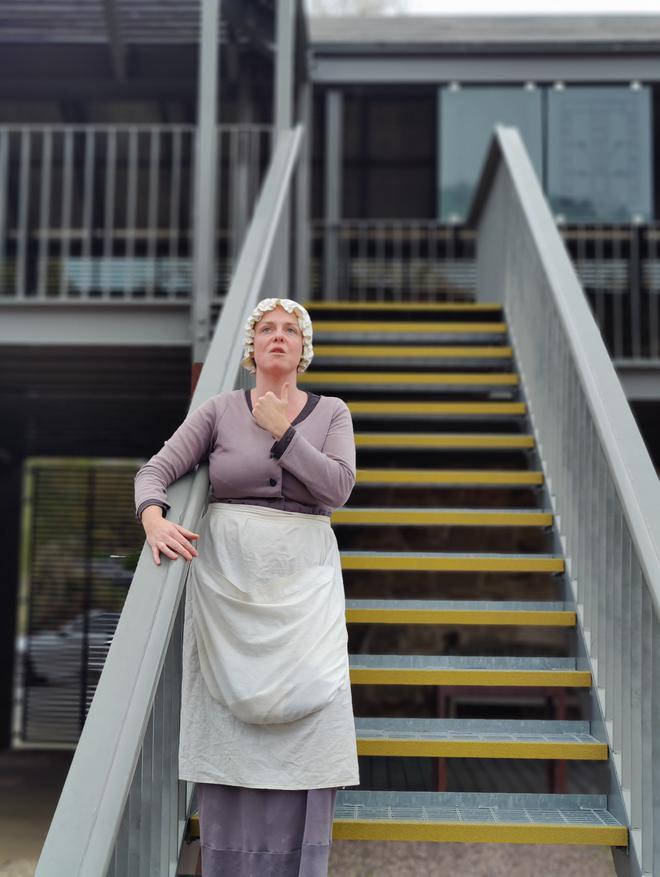Charlotte Williams with red hair, 56, from Wales, was imprisoned for 14 years for stealing sheep; Mary Ann Cummings, 35, from Devonport, was sentenced to seven years for stealing a blanket, shirt and quilt; and Sarah Baker, 20, from Penzance, got life imprisonment for murder. Their names inscribed on small boards lie against the rusty benches of the sprawling prison yard in blustery Hobart, the capital of Tasmania, Australia’s island state.
History whispers from every corner of the forbidding Cascades Female Factory, which operated as a prison for women from 1828 to 1856. Located at the foot of Mt. Wellington along a creek, it is a place with significant aboriginal history, and continued as a gaol under the administration of local authorities from 1856 until 1877.
It reopened in March this year with a $5 million state-of-the-art history and interpretation centre. Thanks to a sustained advocacy campaign, the site is today conserved as an important part of Australia’s history.
Half the population of Tasmania has convict ancestry, and this site attests to the tenacity and strength of these women. In 2010, it was included in the World Heritage list.
I enter the museum and site on a cold autumn day, through a narrow path, ringing with the audio tracks of various women convicts explaining where they came from. The actual site, divided into different yards, is today almost bare, shorn of any buildings except some like the matron’s quarters.
New on Netflix: ‘Money Heist: Korea,’ ‘Extraordinary Attorney Woo,’ and more
Punishing defiance
I imagine the lives of these women transported thousands of miles from home, some nursing their young ones, coping with loneliness, ill health and hard labour, inside those grim sandstone walls.
Signs painted on the floor indicate areas once occupied by the various cells and yards, and rust-coloured steel benches and signposts tell the stories of some of the convicts. A big copper plaque has adjectives taken from prison records to identify the women: pock-marked, scars on forehead, a broken nose.
In one yard stands a life-sized bronze statue of a defiant woman in an 1800s style dress and hat, with her chin up in the air. “Life was hard inside the prison walls with assigned duties up to 12 hours a day, and defiant women were punished for as much as singing, with ration reductions, solitary confinement, having their bedding removed, or their hair cut or hard labour at the washtubs,” explains our guide.

What makes the brutal events of the past come alive for me is the dramatic and evocative ‘The Proud and the Punished’ tour we take in the gargantuan Yard One, where local actor Karissa Lane, dressed in a simple grey Victorian gown and white bonnet, acts out a monologue, playing the roles of six women who spent their lives within these walls: from Sarah Mason, who stole a pair of boots and was sentenced to seven years transportation and infamously sang during silent treatment because ‘it made her think of sunshine’, to Mary Hutchinson, superintendent and matron, who set up the first nursery inside the hospital premises and willed the ‘children to have better lives than their mothers’. “Three out of 10 babies would not make it thanks to neglect, poor hospital facilities and malnutrition,” says Lane, whose ancestor Mary Leary too was an inmate here.
Convicts from the U.K. and Ireland
As many as 7,000 women convicts from the U.K. and Ireland incarcerated for petty offences like stealing a pair of boots or a loaf of bread have passed through these portals. Transportation to Australia became a popular mode of punishment with rising crime in industrialised Britain, and also as a move to colonise Australia which was rich in timber and flax. An estimated 1,60,000 convicts were sent to Australia between 1788 and 1868, out of which approximately 25,000 were women.
Not everyone survived the horrors and hardship. “The factory was damp and cold with icy winds and poor ventilation. Between 1828 and 1879, 220 women died here — some in childbirth and some from illnesses such as tuberculosis,” says our guide.
As I leave the prison walls, Lane’s voice, as one of the convict characters, rings in my ears. She says the prison could destroy everything but not “break her mind”. These resilient women who became extraordinary in adversity finally have a site that commemorates and celebrates their courage. After all, many of them are the founding mothers of Australia.
The freelance travel writer and photographer is based in Chennai.







